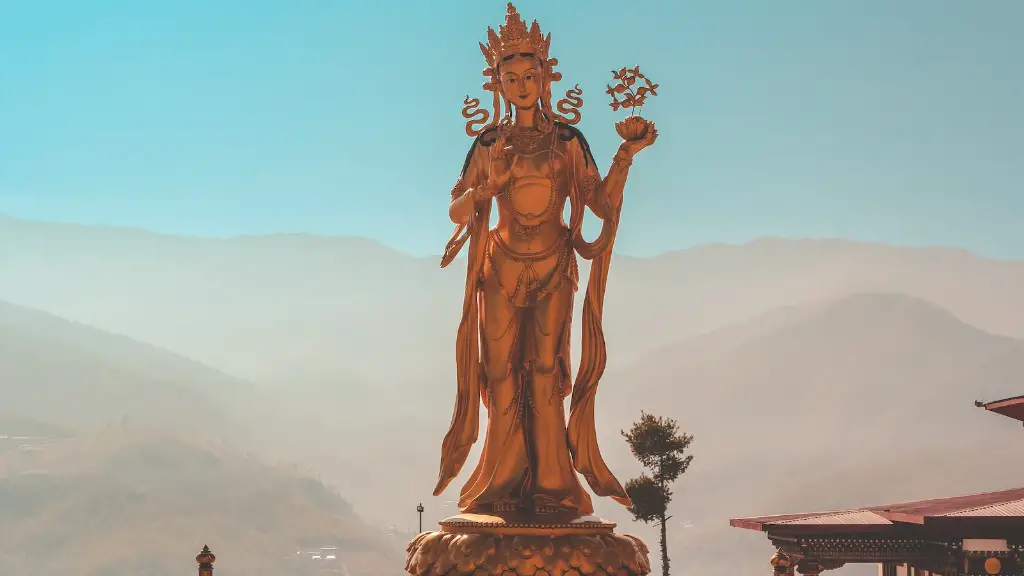Tibetan Buddhism is a rich and diverse tradition that emphasizes personal practice and meditation. In this article, we’ll explore how to meditate in the Tibetan Buddhist tradition. We’ll cover the basics of Tibetan Buddhist meditation, including posture, breathing, and focus. We’ll also explore some of the more advanced practices, such as visualization and tantric meditation. With a little effort and practice, anyone can learn to meditate in the Tibetan Buddhist tradition.
In Tibetan Buddhism, there are many different types of meditation, each with its own purpose. To begin meditating, it is important to find a comfortable place where you will not be interrupted. It is also helpful to set a specific time for your meditation practice.
To start, sit in a comfortable position with your spine straight and your eyes closed. Take a few deep breaths and allow your body to relax. Once you are settled, begin to focus your attention on your breath. Simply observe the sensation of your breath as it enters and leaves your body. If your mind begins to wander, simply bring your attention back to your breath.
With regular practice, you will develop greater focus and concentration. You may also want to explore other types of meditation, such as visualization or mantra recitation.
What is the Tibetan Buddhist style of meditation?
Visualization practices are often used in Tibetan Buddhist meditation in order to develop positive qualities such as compassion and goodwill. In these practices, meditators imagine themselves and/or others as fully benevolent beings, and the environment as a pure, heavenly realm. By doing so, they hope to cultivate these positive qualities within themselves.
Breathing is one of the most natural things we do, and yet it is also one of the things that we can control. By paying attention to our breathing, we can control our stress and anxiety levels. When we are stressed, our breathing becomes shallow and we take shorter breaths. By focusing on our breathing and taking deeper breaths, we can relax our bodies and minds.
This exercise is about being aware of your breathing and letting go of your thoughts. Just breathe normally and pay attention to your breathing process, one breath at a time. Keep your awareness focused but be gentle; you should have an attitude of discovering and making friends with yourself. Acknowledge the thoughts that pop into your mind without engaging them. Simply observe them and let go.
What is the Tibetan mind technique
Lojong is a contemplative practice in the Tibetan Buddhist tradition which makes use of various lists of aphorisms or slogans which are used for contemplative practice. The practice involves refining and purifying one’s motivations and attitudes. Lojong slogans are intended to provoke a shift in the way we see the world, and ourselves. They are meant to help us let go of our usual way of thinking, which is often based on fear, and instead see the world from a place of love.
The Drak Yerpa Monastery is a sacred site in Tibetan Buddhism, said to have exactly 108 caves. These caves are used as places of meditation for monks, and the number is seen as auspicious. However, meditation is not limited to the caves at Drak Yerpa. There are many other places on the site that are also used for this purpose.
What are the 3 main beliefs of Tibetan Buddhism?
Tibetans commonly draw a distinction between three religious traditions: (1) the divine dharma (Iha chos), or Buddhism; (2) Bon dharma (bon chos); and (3) the dharma of human beings (mi chos), or folk religion.
Buddhism is the tradition that focuses on the teachings of the Buddha and the path to enlightenment. Bon dharma is the indigenous Tibetan religion that predates Buddhism and is based on animism and shamanism. The dharma of human beings is a catch-all category that includes everything else, such as Chinese folk religion, Hinduism, and Islam.
Meditation is a process of turning one’s attention inward, away from the external world. The purpose of meditation is to calm the mind and body, and to bring about a sense of inner peace.
There are many different types of meditation, but all share the common goal of promoting relaxation and stillness.
Here are five essential points to keep in mind when meditating:
1. Awareness of the present moment: One of the most important aspects of meditation is being aware of the present moment. This means letting go of thoughts about the past and the future, and simply focus on the here and now.
2. Subduing the negative mind: In order to achieve inner peace, it is necessary to first calm the negative mind. This can be done by focusing on positive thoughts and images, and by letting go of negative thoughts and emotions.
3. Mindfulness of the meditation object: The meditation object can be anything that you focus on during the meditation, such as your breath, a mantra, or a certain image. It is important to be aware of the object of your meditation, and to let go of any other thoughts or distractions that may arise.
4. Dawning awareness: As you become more experienced
How do I know if I’m meditating correctly?
One of the first signs that you’re meditating correctly is a sense of heightened awareness. This simply means that you become more aware of your surroundings, and of your own thoughts and feelings. You may notice things that you’ve never noticed before, or start to pay attention to things that you normally wouldn’t.
There is no wrong way to do deep breathing. The main thing is to focus on taking deep, relaxing breaths. You can do this sitting or lying down in a comfortable position. You can keep your eyes open or closed, whichever feels more relaxing. And don’t worry about breathing in a specific way. Just let your breath flow naturally.
Is there an incorrect way to meditate
Everyone’s needs are different, so it’s important to find a type of meditation that works for you. There are nine popular types of meditation, each with their own benefits:
1. Mindfulness meditation. This practice involves focusing on your breath and being aware of your thoughts and surroundings. It’s a great way to learn to focus and be present in the moment.
2. Guided meditation. This type of meditation involves following along with a recorded voice or music. It can be helpful if you find it difficult to focus or quiet your mind on your own.
3. Transcendental meditation. This practice involves repeating a mantra or word to yourself. It’s a great way to focus and quiet your mind.
4. Movement meditation. This type of meditation involves gentle movement, such as yoga or Tai Chi. It’s a great way to get your body moving and release any tension you may be holding.
5. Body scan meditation. This practice involves focusing on each part of your body, from your toes to your head. It’s a great way to relax your body and mind.
6. Visualization meditation. This type of meditation involves picturing a peaceful place or scene. It can be a great
There are five basic elements in Tibetan Buddhism: earth, water, fire, air, and space. Each element has its own qualities and symbolism. The elements are used in various rituals and practices, such as meditation, mantra recitation, and iconography.
What are the 4 thoughts that Turn the mind to Dharma?
The Karmapa is the head of the Karma Kagyu lineage of Tibetan Buddhism. He began his teaching by naming the Four Thoughts That Turn the Mind from Samsara. These four thoughts are:
1. The precious human rebirth
2. Death and impermanence
3. Karma as cause and effect
4. The defects of samsara
By contemplating on these four thoughts, we can develop a renunciation of samsara and trappings of worldly life. This will lead us to the path of liberation and enlightenment.
As you begin practicing the rites, it is best to start with doing them 3 times a day. From there, you can add 2 repetitions per rite each week until you are doing 21 rounds of each rite every day. While it is important to practice the rites frequently, it is also important to listen to your body and go at a pace that feels comfortable for you.
Which mantra is used by Tibetan Buddhists
The first word, aum/om, is a sacred syllable in various Indian religions. It is often used as a meditative practice to help focus the mind and achieve a state of enlightenment. In Tibetan Buddhism, the use of this mantra is widespread and is considered to be the most popular form of religious practice, performed by laypersons and monastics alike. The humming sound of the mantra is believed to represent the spirit of enlightenment, which is something that everyone can strive to achieve.
Tibetan Buddhism is a type of Mahayana Buddhism that includes tantric practices and additional methods to achieve Buddhahood. The main goal of Tibetan Buddhism is to achieve Buddhahood, which is a state of perfect enlightenment. Tibetan Buddhism includes the six perfections, which are the practices of giving, ethics, patience, effort, concentration, and wisdom. Tibetan Buddhism also includes tantric practices, such as deity yoga and the Six Dharmas of Naropa, as well as methods that are seen as transcending tantra, like Dzogchen.
How long can Tibetan monks meditate?
The monks wake up at 400 am and meditate for one hour. They then chant for one hour. At 600 am, they walk around the neighbourhood barefoot while the local people make merit by offering them food.
Buddhists do not believe in any kind of deity or god, although there are supernatural figures who can help or hinder people on the path towards enlightenment. The Buddha himself was a human being who achieved enlightenment through his own efforts, and it is possible for others to do the same.
Conclusion
There is no one answer to this question as meditation techniques can vary depending on the specific tradition of Tibetan Buddhism that you are following. However, some general tips on how to meditate in the Tibetan Buddhist tradition could include finding a comfortable and calm place to sit, focusing on your breath, and mantra recitation.
In Tibetan Buddhism, meditation is used as a way to gain a deeper understanding of the mind and to cultivate compassion and wisdom. Through meditation, practitioners can develop a more clear and concentrated mind, which allows for greater insight and compassion.


